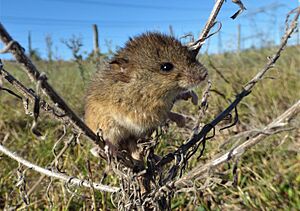Flavescent colilargo facts for kids
Quick facts for kids Flavescent colilargo |
|
|---|---|
 |
|
| Conservation status | |
| Scientific classification | |
| Genus: |
Oligoryzomys
|
| Species: |
flavescens
|
The Oligoryzomys flavescens, also known as the flavescent colilargo or yellow pygmy rice rat, is a small rodent. It belongs to the Oligoryzomys genus in the Cricetidae family. This rat lives in southern South America. You can find it in southern Brazil, Paraguay, Uruguay, and northeastern Argentina.
Contents
About the Yellow Pygmy Rice Rat
The fur on the back of the yellow pygmy rice rat is a mix of bright orangish-brown and black hairs. The hairs on its sides are all orange. Its belly is yellowish-grey. The colors blend smoothly from its back to its belly.
Size and Appearance
This small rodent has an average head and body length of about 87 mm (3.43 in). Its tail is usually longer, averaging about 110 mm (4.33 in). If you look at its skull, you'd notice some special features. It has long openings in the roof of its mouth, called incisive foramina, that usually reach its first molar tooth. It also has a short depression behind the palate, called a mesopterygoid fossa.
Where the Yellow Pygmy Rice Rat Lives
The yellow pygmy rice rat is native to South America. It lives in eastern Brazil, Uruguay, eastern Paraguay, and parts of northern and central Argentina.
Habitats and Environment
This rat can live in many different places. It often prefers areas close to water. You can find it from sea level up to about 1,800 m (5,900 ft) high. Its homes include wide grasslands called pampas, bushy scrubland, and both old and new forests. It also lives in marshes, on farms, and in gallery forests within the cerrado region.
Understanding the Yellow Pygmy Rice Rat's Role in Nature
The yellow pygmy rice rat is important in its ecosystem. It can carry certain tiny germs called hantaviruses. These germs do not harm the rats themselves. However, if humans come into contact with these germs, they can sometimes get sick.
Conservation Status of the Yellow Pygmy Rice Rat
The International Union for Conservation of Nature (IUCN) checks on how many animals are left in the wild. They have listed the yellow pygmy rice rat as a species of "least concern".
Why It's Not Endangered
This means that scientists are not worried about this species disappearing. There are several reasons for this good status:
- It lives in a very wide area.
- Scientists believe there are many of these rats in total.
- It lives in several protected areas, which helps keep its homes safe.
- It can handle some changes to its habitat, like when humans disturb the land a little.


